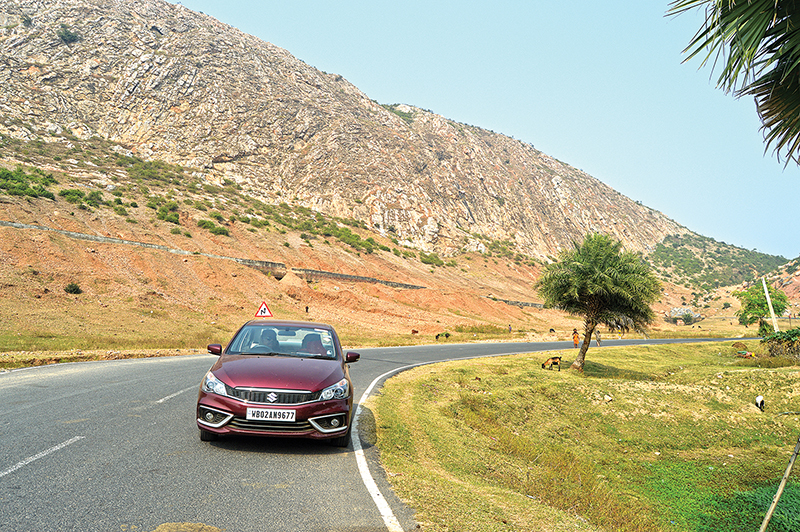
Team WHEELS on way to Rajgir
“As soon as I’m on the road, I see, often palpably, that I know nothing at all, which is always a great liberation”- Pico Iyer. Thus do we often come to the realisation that the best way to learn about the world is to experience it firsthand. Team WHEELS decided to extend its Bodh Gaya spiritual sojourn to the ‘city of seven hills’ – Rajgir and Nalanda in Bihar, about 512 km from Kolkata.
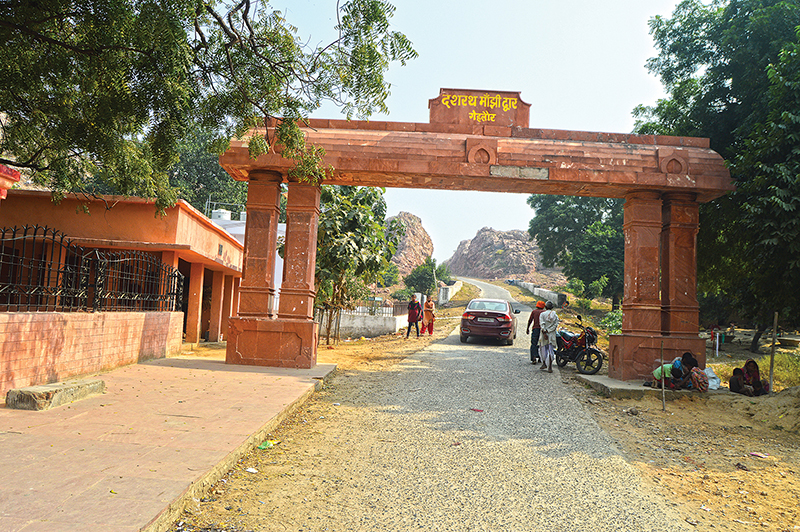
The Dasrath Manjhi Dwaar
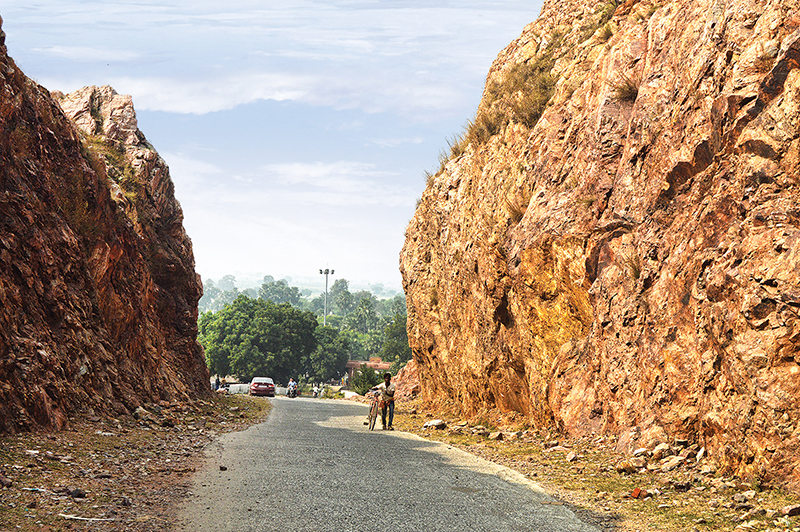
The passage cut through the rocks by Dasrath Manjhi
Route:
Reach Vidyasagar Setu and enter Kona Expressway to connect with NH-19 (NH-2). Drive through Bardhaman, followed by Durgapur and Asansol. Thereafter, follow the NH-19 (NH-2) over Nirsa, Govindpur, Dhanbad, Topchachi, Bagodar till you reach Yadav Chowk in Barhi. Enter Dhanbad Road taking the left of the Y fork at Barhi to reach Barhi Chowk.
Turn right from Barhi Chowk towards Nawada and pass through the enormous Tilaiya Dam, Jhumri Telaiya followed by the winding roads of Koderma Pass – a Ghat section with thick forests on either side. Cross Rajauli, Nawada and Mufassil and reach Giriyak Chowk. Finally take a left from Giriyak Chowk towards Rajgir Town.
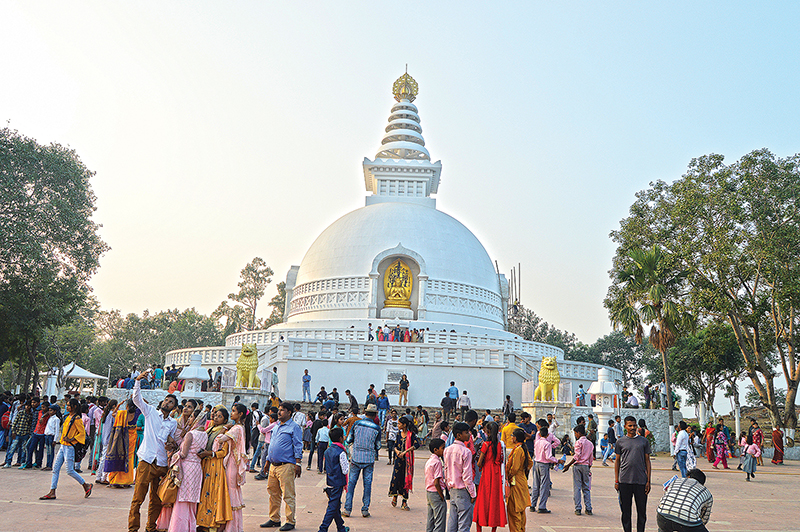
Vishwa Shanti Stupa atop Ratnagiri Hills
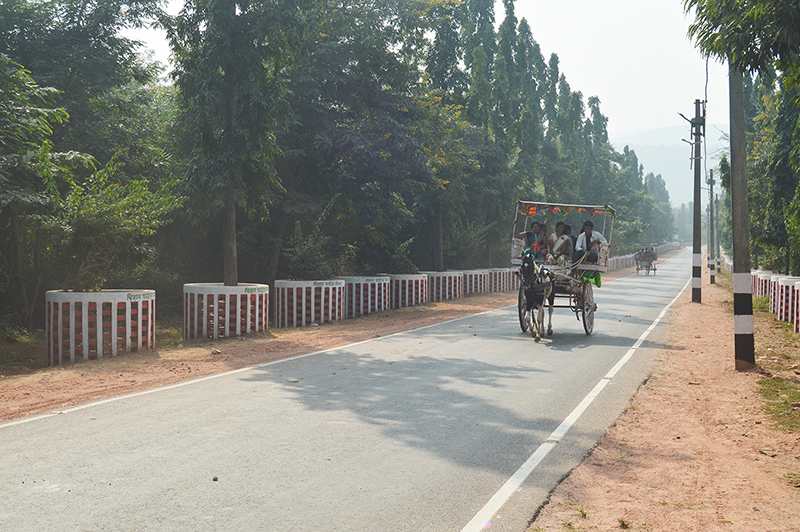
Tongas heading to the Rajgir Ropeway
Dashrath Majhi Dwar
Team WHEELS, however, drove from Bodh Gaya, passing by the man-made wonder – the ‘Dasrath Majhi Dwaar’ to reach Rajgir.
Driving past the Gehlore Hills, we crossed the beautiful ruby-red sandstone Manjhi Gate emblazoned with the words ‘Dasrath Manjhi Dwaar’.
As the story entails, Dasrath Manjhi, a poor villager, lost his wife Falguni Devi, when she tried to carry some water for him, traversing the narrow path across the tall hills of Ghelore Ghats.
Struck by his loss, Manjhi began chipping away one of the hills with simple tools and for creating a road that would help reach his village directly from the fields, without having to climb the hill.
In 1982, after 22 years of back-breaking labour, the 'Mountain Man' finished the 360-foot long road cutting straight through the hill. The road not only reduced miles of travel for countless villagers, but also made traversing the area safer, giving way to vehicles.
Rajgir
By the time we reached Gargee Gautam Vihar Resort in Rajgir, it was 12 pm. The sprawling resort stood right on the highway. After some delicious oven fresh north Indian food, we set off to explore some of the local attractions.
The name Rajgir is supposed to have emerged from the Sanskrit word, R?jagriha, meaning ‘house of the king’ or ‘royal house’. The city sits in a valley surrounded by seven hills: Vaibhara, Ratna, Saila, Sona, Udaya, Chhatha and Vipula.
Ropeway
The main attraction of this city happens to be the ropeway that carries tourists to the top of the Ratnagiri Hill (about 1150 ft high). We parked our car in the huge parking area inside the ropeway premises. The tiresome ordeal of buying a ticket and having to wait in queue to grab our seats at the ropeway was duly rewarded. In a thrilling ride up the hill in the cable car, we watched the widening of the gap between our feet and the slopes of the hill.
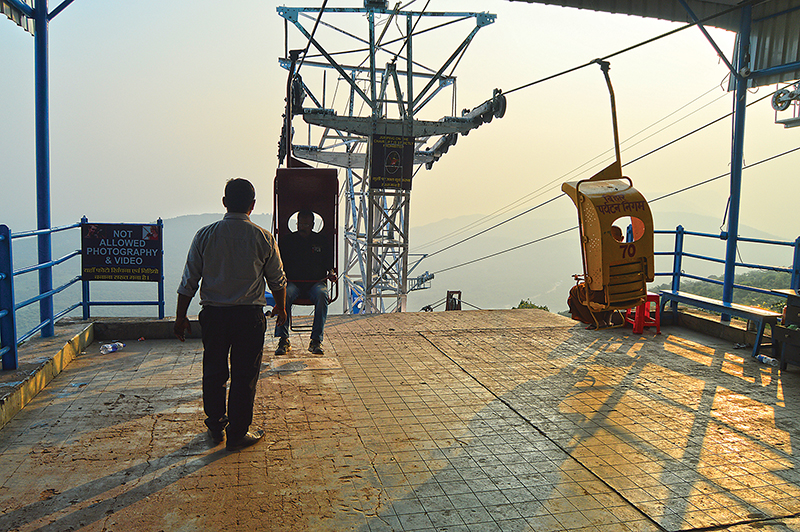
The ropeway station atop Ratnagiri Hills
The wheel of the ropeway operates on the mechanism of a single fixed pulley. While one arm goes uphill, the other moves downhill unceasingly. Interestingly, an assistant holds the chair and helps board the passengers on the move – a process completed within a matter of seconds for each. So expert are these assistants that it is both safe and fun. Thereafter, it takes just seven and half minutes to reach the hilltop by the ropeway.
There are about a hundred seats in the ropeway. However, the Bihar Tourism Dept. is now developing a different cable line to run 8-seater cabins for passengers. These will have higher passenger capacity as also improve the safety factor. The new ropeway is likely to become operational by February-March 2020.
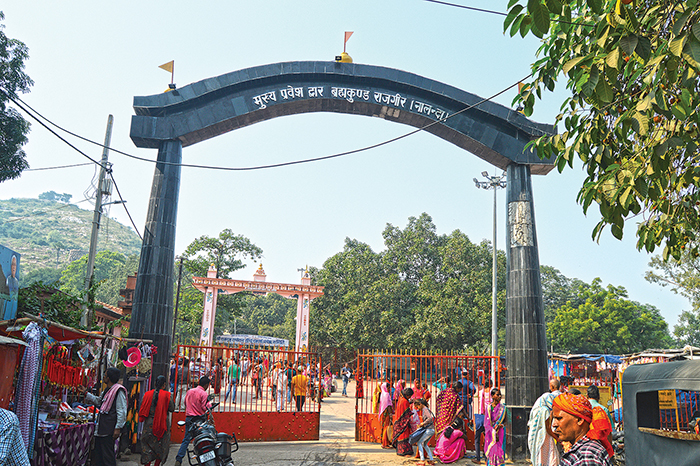
Entrance of the Brahma Kund hot springs
Vishwashanti Stupa
Getting off the ropeway, we walked to the beautiful Vishwashanti Stupa. Buddhist pilgrims prefer to take the stairway of the hill to reach the stupa. Built in 1969, the majestic stupa on top of the Ratnagiri Hill has four golden statues of the Buddha adorning its dome. The circular dome has a diameter of 144 ft and a height of 160 ft. The dazzling white structure can be seen from a long distance. Adjacent to the stupa is the Japanese Buddhist Temple – Na-Mu-Myo-Ho-Ren-Ge-Kyo – a phrase expounded by the 13th century Japanese Buddhist monk, Nichiren. The chant translates loosely to ‘I devote myself to the Mystic Law of the Lotus Sutra’. We sat in silence, soaking in the serenity. Later, we gasped at the view of Rajgir Town surrounded by hills on all sides, as seen from the hilltop. Time was ticking so we proceeded towards another major attraction – the hot springs.
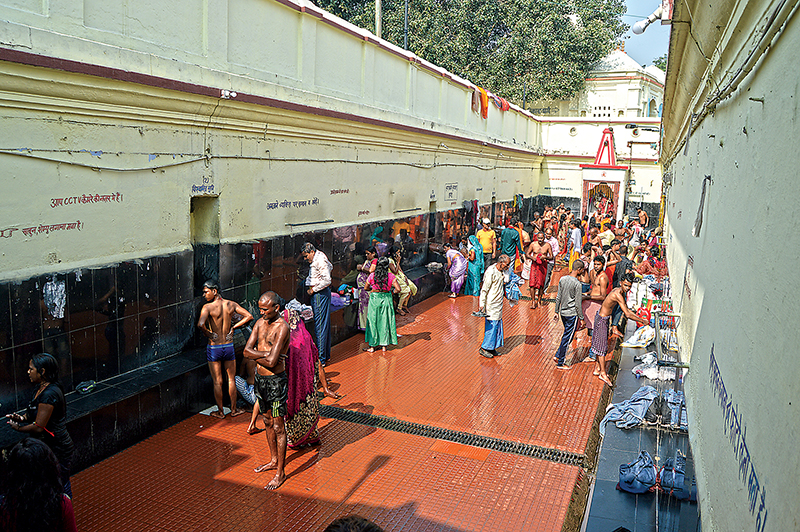
Devotees taking the holy bath at the Brahma Kund hot springs
Brahma Kund – Hot Springs
The hot springs of Brahma Kund at Rajgir is a sacred place for Hindus. Here water from seven different springs (Saptarshi) merge. In the heart of the town, on the highway, we entered through the tall gate and climbed the stairway leading to the Brahma Kund. The Kund complex has a large number of temples of Ram, Lakshmi Narayan, Mahakaleshwar, and so on.
Small outlets in the shape of a crocodile’s mouth, spout hot water, at the sanctum of each rishi – Agastya, Atri, Bhardwaja, Gautam, Jamadagni, Vashistha and Vishwamitra. We watched as fervent devotees tried to wash off their sins and purify themselves in the spring-water.
The hot springs are believed to have miraculous healing properties for all kinds of skin and bone ailments. This is actually credited to the mineral-rich water of Rajgir, especially sulphur. Allowing the hot water to flow over our fatigued limbs we felt there could hardly be a better sauna bath.
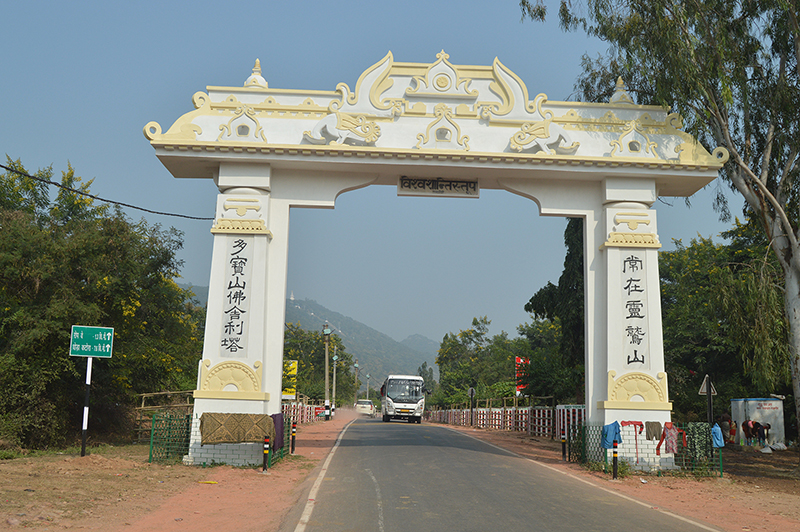
The entrance to the Vishwa Shanti Stupa
Sone Bhandar
Next came the caves of Sone Bhandar, located off the highway, amidst woods. We drove through several metres on the laterite to reach the 1700 year old caves. The inscriptions etched in Sakhlipi script were read out dramatically by the local guide – an old man with a flowing beard. His dark grey robe was darker than the clouds above us.
Sculptures of Jain Tirthankaras were carved into the walls of the cave by the Jain sage, Bajradeo in around 300 AD. It was in these caves that Tripitaka, the holy book of the Buddhists, is said to have been written. Yet people prefer to hear the legends about the Sone Bhandar as the hidden treasure house of King Bimbisara.
This concluded our tour of the town. Retreating to our resort, we relaxed at the pool-deck restaurant. Sipping iced teas oozing the freshness of mint and lime and biting into meaty chunks of spicy hot kebabs was soul food for our frazzled city nerves. With plans of an early start the following morning, we wrapped up and retired to bed.
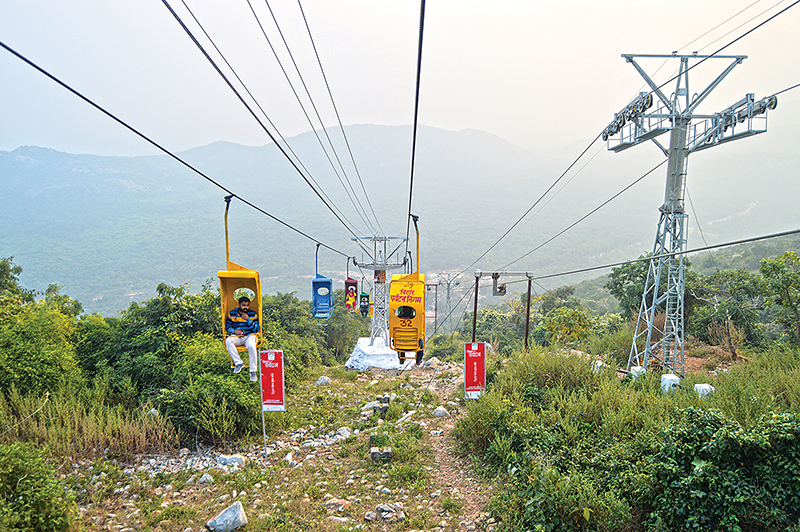
The hanging chairs of Rajgir ropeway
Nalanda
The next morning, replete with breakfast buffet bonhomie, we set off for the most awaited destination – Nalanda.
About 14 km from Rajgir, Nalanda Mahavihara was once known as the zenith institution for knowledge. The grand residential university throve in the kingdom of Magadha, during the golden age of the Guptas. An international centre of learning, Nalanda flourished in the 5th and 6th centuries and later under Harshavardhan, the emperor of Kanauj, in the 7th century.
Nalanda was said to have been burnt and destroyed by an army of the Delhi Sultanate led by Bakhtiyar Khilji in the 12th century. It is said that the university was home to 10,000 students and 2,000 teachers, who lived and learnt in a symbiotic way – a phenomenon then prevalent in the education system.
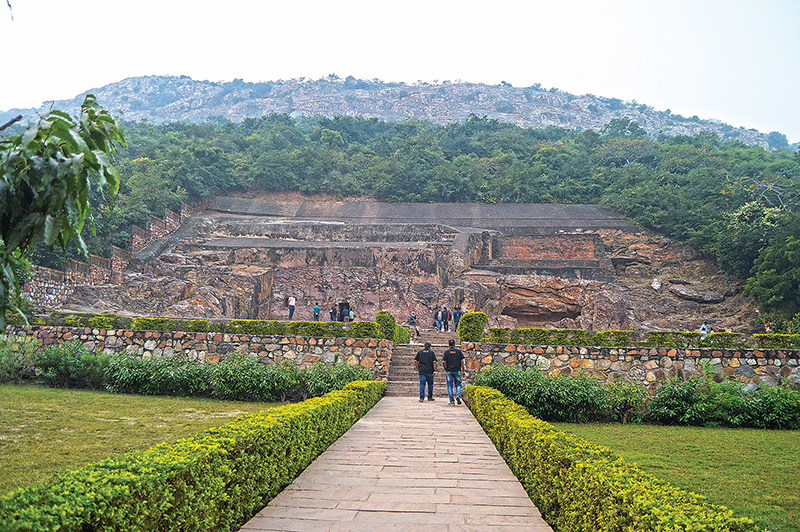
The caves of Sone Bhandar
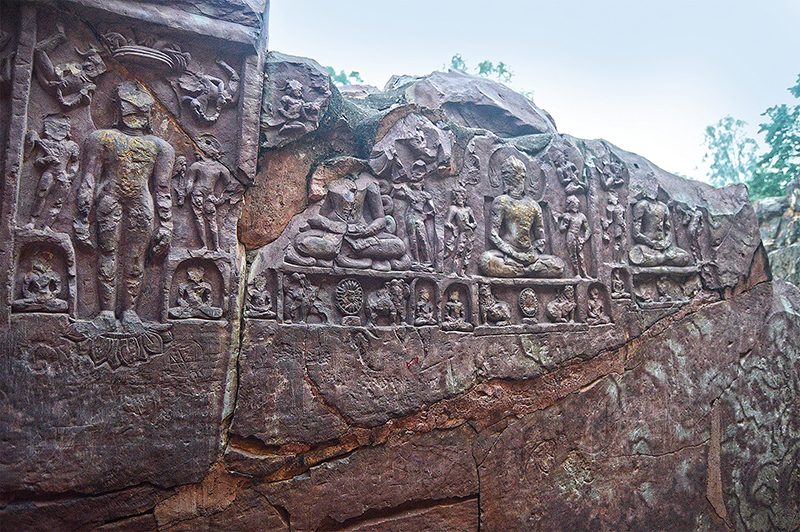
The sculptures of 3rd century Jain Tirthankara – Sone Bhandar
The campus
Not all those who wander are lost; not all classrooms have four walls –were thoughts that sprang to mind when we caught our first glimpse of the sprawling campus of the University. Nalanda may be a popular tourist destination for the rest of the world, but for us it was akin to a pilgrimage.
We marvelled at the sight of the huge campus. As we entered the precincts of the red-brick walls and the stupas, we shivered in excitement. The meticulously planned architecture, the student cells, the library, the storage and the drainage system, led us back into the annals of history. We could almost visualise the thriving bustling activity of its heydays. We touched our heads in veneration to the sacred soil from which arose this magnificent epitome of education. Every year lakhs of students, research scholars and historians the world over throng to visit Nalanda.
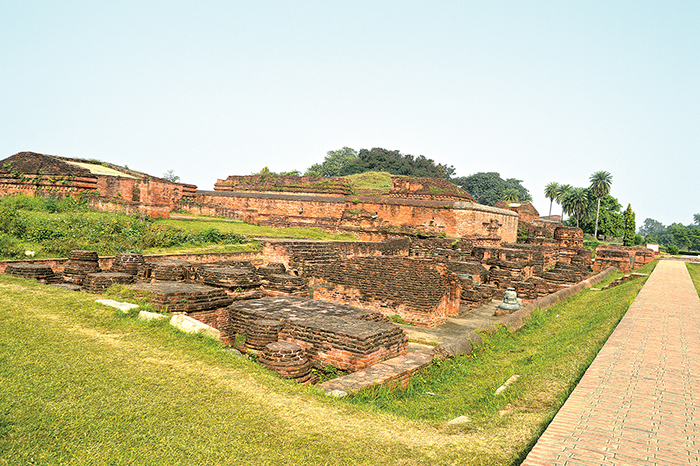
The huge excavated site – Nalanda
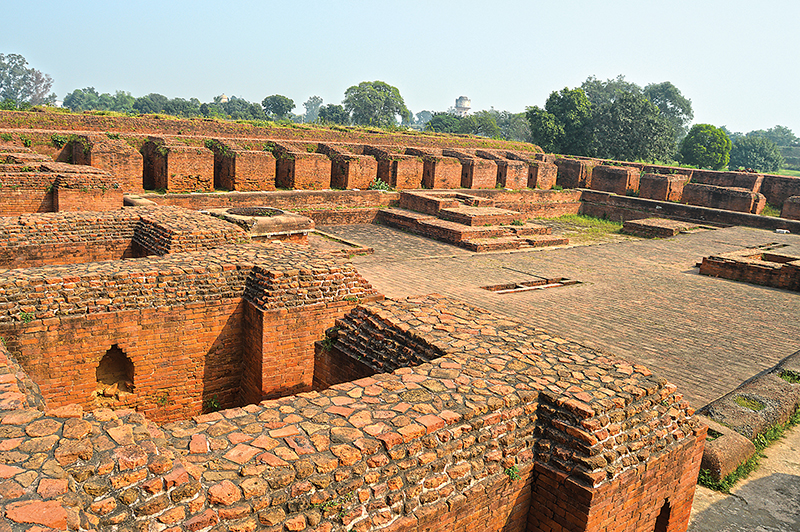
The ruins of Nalanda showing meticulously planned students cells
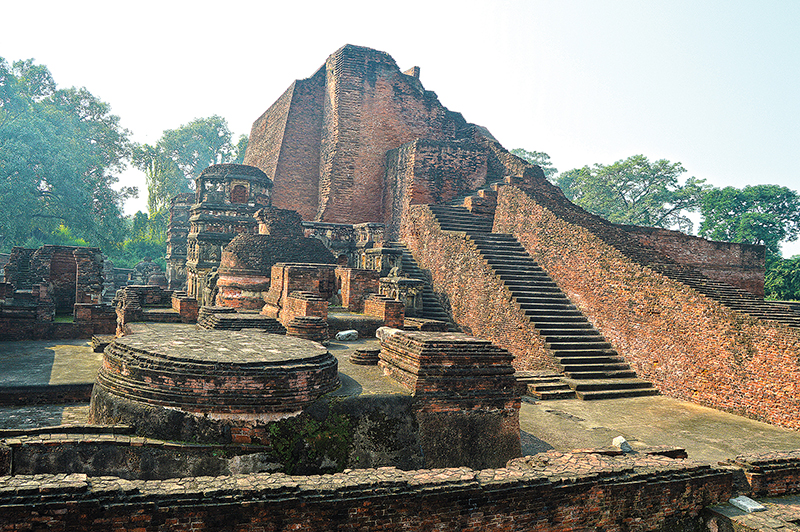
The signature pyramidal structure of Nalanda ruins surrounded by small stupas
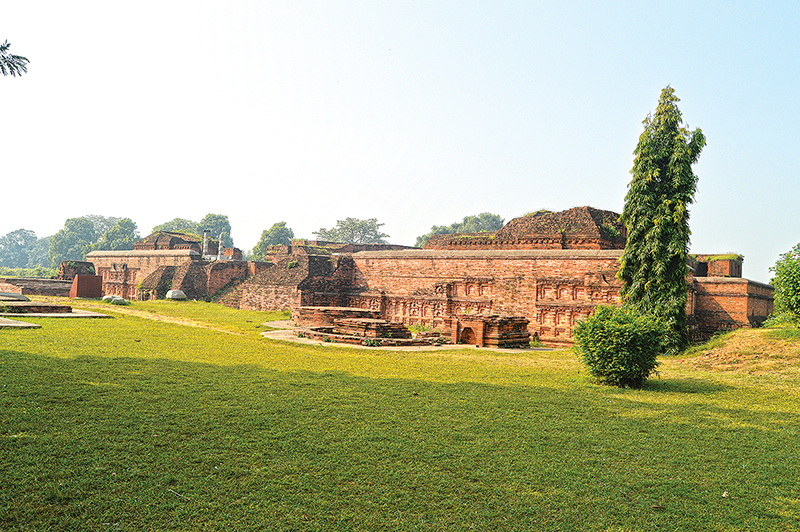
Remains of the sprawling campus of the Nalanda University
The ruins of Nalanda was discovered by the Archaeological Survey of India after a systematic excavation between 1915 and 1937. A second round of excavation followed during 1974-1982. The current excavation site spreads across 14 acres of land. However, if we tally the area with that described in the writings of 7th century Chinese travellers, it appears that the excavated part is just about 10% of the actual area over which the original institute existed.
The red brick structures of the buildings are divided by a central walk-way that goes from south to north. The monasteries or the Viharas lie to the east of this central alley and the temple to the west. The Vihara-1 is perhaps the most interesting with its cells on two floors built around a central courtyard where steps lead up to what must have been a dais for the professors to address their students from. A small chapel still retains a half-broken statue of the Lord Buddha.
The enormous pyramidal mass of Temple no. 3 is impressive and from its top commands a splendid view of the entire area. It is surrounded by smaller stupas, many of which are studded with small and big statues of the Lord Buddha in various mudras (poses).
We Indians ought to be proud to have been the pioneers in spreading world-class education some thousand years back. We brought so many countries under one roof. It is sad that today, despite having such inspiration in the form of the ruins of Nalanda, we try to emulate the West and copy their education system instead of building on and improving our own.
Experiencing Nalanda helped us actively grapple with our own darkness. When we left we did so with a heavy heart.
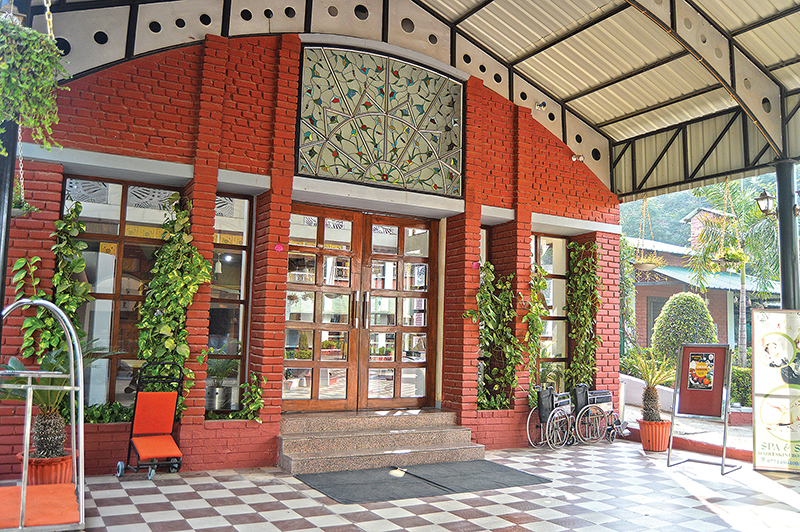
Beautiful reception area – Gargee Gautam Vihar Resort
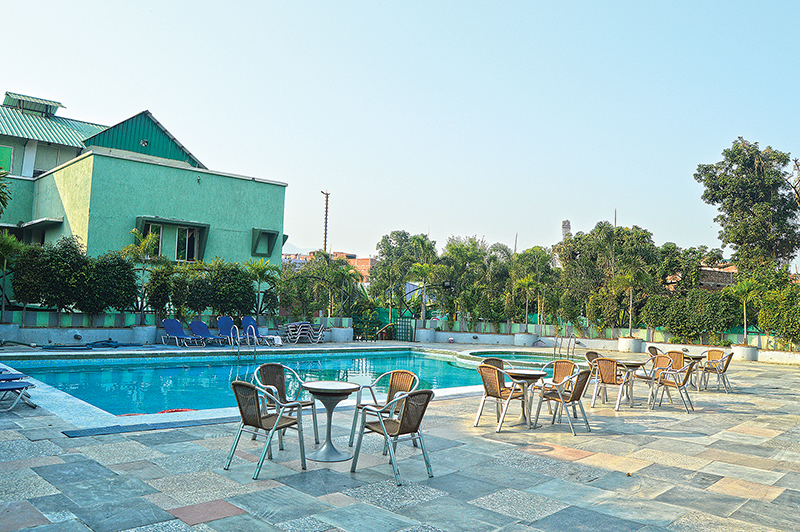
Inviting blue of the swimming pool – Gargee Gautam Vihar Resort
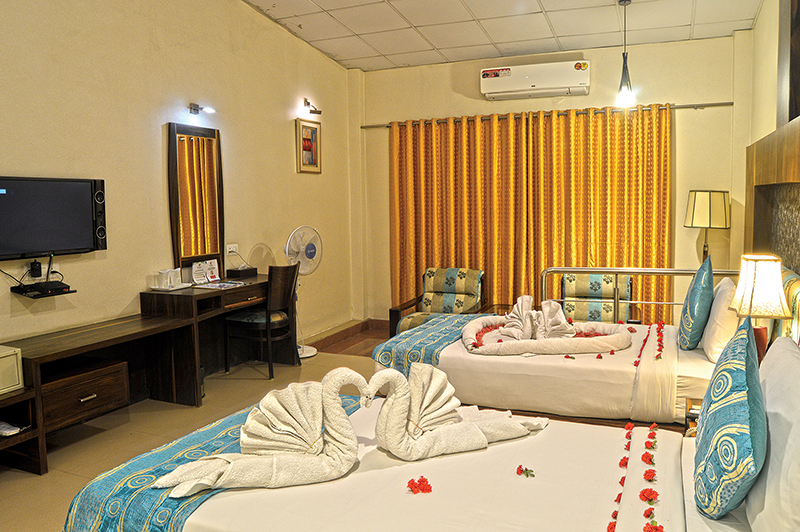
An exquisite suite – Gargee Gautam Vihar Resort

Lavish restaurant – Gargee Gautam Vihar Resort
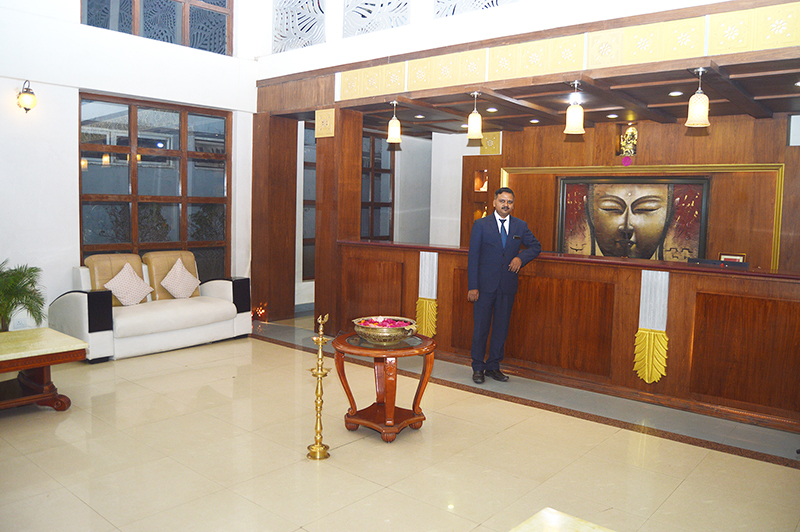
The lounge – Gargee Gautam Vihar Resort
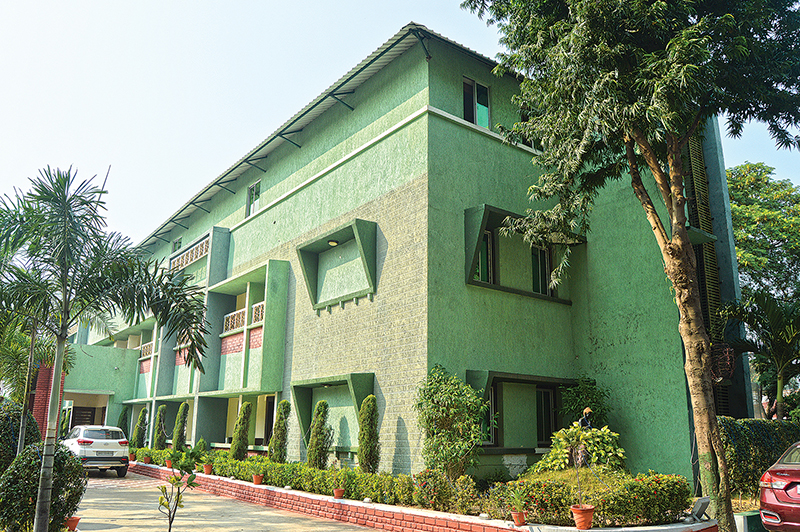
The green facade – Gargee Gautam Vihar Resort
Accommodation
When planning a visit to Rajgir, you cannot think of a better place than the Gargee Gautam Vihar Resort. Standing tall on the highway, the resort has a sprawling complex. From lavish guestrooms to multi-cuisine restaurant, conference room and banquet, swimming pool, gymnasium, indoor games, outdoor sports, adventurous activities, spa-salon services – you name it, they have it.
There are 51 elegant guest rooms, each with a private balcony. The soft dewy grass of the garden, the aquamarine blue of the swimming pool invite you to sunbathe, after an indulgent spa, on the relaxing chairs by the pool.
Food
We recommend you stick to the pan-Indian genre. Service is reasonably fast and the staff are friendly. However, bars are closed in Bihar since liquor is prohibited in the state.
Come to think of it, this probably is the best kind of travel – the opportunity to strip life to its essentials, to remind ourselves of what culture exists for in the first place: to help us survive life’s travails, to make us strong, to keep us going. And it certainly helped to put our own bourgeois ‘travails’ in perspective. We had survived our own existential crisis and bridged the gap between the spiritual enlightenment of Bodh Gaya and the intellectual awakening at Nalanda. Au revoir our trusty steed, our beautiful four-wheeled wonder – till we meet at land’s end on another trip next month, once again. Happy wheeling, for the journey continues…
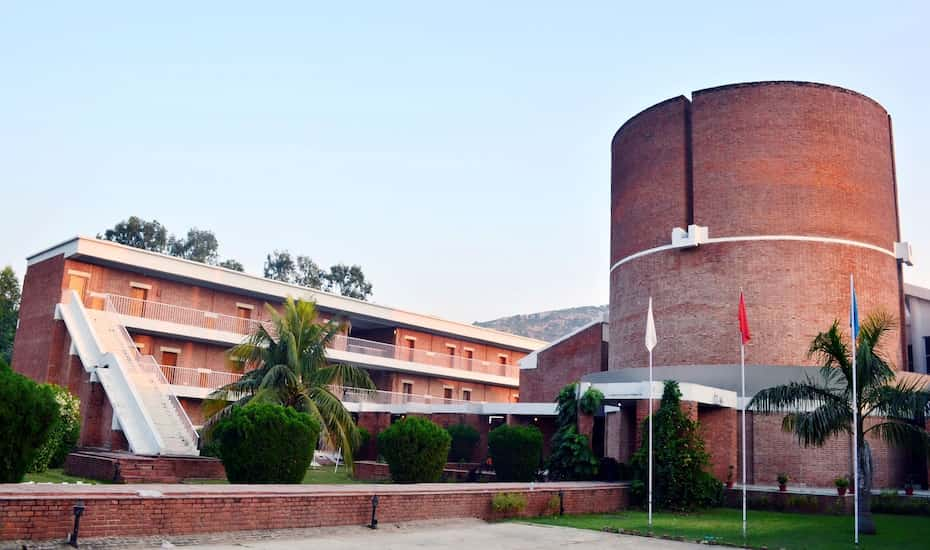
Standard : B+

Standard : A